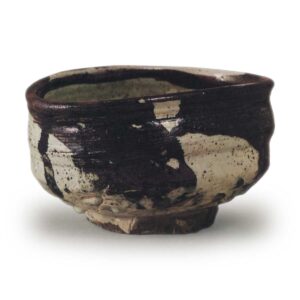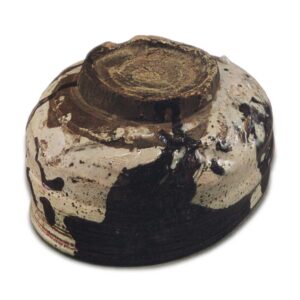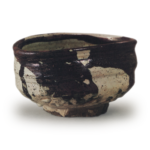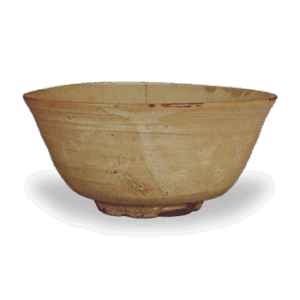

Important Cultural Property
Held at: Fujita Art Museum
Height: 6.3 – 7.5cm
Diameter: 9.8 – 13.1cm
Outer diameter of foot ring: 6.4cm
Height of foot ring: 1.2cm
The Kurofuke Gosomaru is the most unrestrained and dynamic in shape and color of all the Gosomaru, and is said to be the best of its kind. The name Yūhi (evening sun) is thought to have been given because of the faint reddish color on the surface of the bowl, which resembles the evening sky.
The Kurofuke Gosomaru is said to have been made to order from Japan, specifically modeled on the Kuro Oribe. Looking at the shape and color, it does seem to be the case, but it is not simply a case of following the shape and color of the Kuro Oribe externally, but rather it is a completely unique Joseon tea bowl that freely and boldly demonstrates the characteristics of the Joseon potters, and has absorbed the style favored by Oribe.
First of all, the shaping using the potter’s wheel is wonderful. As was the case with the Mino potters who fired black Oribe ware, here too the familiar and robust potter’s wheel is the foundation of the shaping. The rise from the waist to the square rim extends straight up, and the body and near the rim are tightly wrapped in strongly-pressed marks, while the vivid wheel marks run roughly or densely in between. The rim of the mouth is rounded and somewhat open. The shape of the rim is slightly distorted, but it does not look forced, and it looks like a natural distortion. In contrast to the upper part of the bowl, which is shaped on the potter’s wheel, the lower part, from the waist to the foot, is entirely shaped with a wooden tool, and the variation in the size of the tool marks is particularly striking. This kind of construction is always seen in Oribe-style tea bowls, but it is much more intense than Oribe tea bowls. The carving of the foot ring is particularly unusual: the outside is roughly hewn into a large, almost hexagonal shape, and the inside is carved shallowly. The bottom surface shows signs of having been scraped. The rough, unfinished surface is like the surface of a rock.
The body is made of white porcelain clay containing a small amount of iron and sand, and is fired to a high degree of hardness. The iron content causes the surface of the foot ring to burn lightly, and the taste of the piece, which has been passed down through the generations, gives it a subdued flavor that makes it hard to believe it is white porcelain. The inside of the bowl is also decorated with a number of clearly visible marks from the potter’s wheel, and the bottom is decorated with a spiral pattern.
The glaze is mostly black, with some white added, but here the white glaze is combined with iron sand glaze to create a different effect. The glaze is rough, bold and unusual, befitting the texture of the base material. In particular, around the hem, the white glaze has accumulated thickly in patches, hanging down in a milky white color, and there are also areas where the glaze has been splashed on thinly and faded, as well as traces of the fingertips, and in places where the glaze is thin, a faint reddish hue can be faintly seen. And on top of this white glaze, the dark iron glaze that has been applied in large, blotchy patches is like a splash of ink, overflowing with energy. The color is not just black, but depending on the heat of the fire, parts of it take on a reddish hue, looking like the color of the setting sun.
It is thought that the black brushwork was created by using a large, wide brush that was thoroughly covered in black glaze and then brushing it on, but it also has a unique glaze texture that cannot be achieved with a brush, and it is thought that it may have been created by pouring glaze on with a ladle.
The origin of the tea bowl is unknown, but it was owned by Kubara Shozaburo in the Meiji era, and in 1900 it was passed on to Inoue Seigai, and in 1925 it was moved to the Fujimachi family. The inner box is made of paulownia wood, and the lid is made of joined pieces of rosewood. The calligraphy on the lid is by Egetsu Osho, and it is inscribed with the words “Yuuhi” (evening sun).








